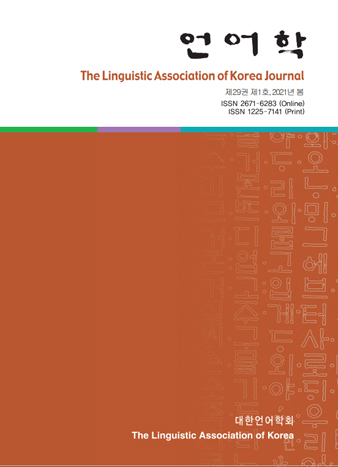대한언어학회 전자저널

29권 1호 (2021년 3월)
- COVID-19 영향으로 인한 한국 이공계 대학생의 영어 온라인수업에 대한 인식 연구
-
차현지 · 김성희
Pages : 49-69
Abstract
Cha, Hyun Ji & Kim, Sunghee. (2021). A study on the perceptions of Korean university students majoring in science and engineering of an online English class during COVID-19. The Linguistic Association of Korea Journal, 29(1), 49-69. This study investigated how Korean college students majoring in science and engineering perceived their general English course held online for one semester during the COVID-19 pandemic. A survey in which 166 students participated was conducted at the end of the first semester of 2020. The results were as follows. First, most of the participants preferred pre-recorded online lectures delivered by their professors. The most common reason given was the flexibility of being able to watch them repeatedly without any concerns about time and place. Second, the preferred evaluation method was to submit only assignments without testing, since students believed this could prevent cheating. Third, the drawbacks of online classes were identified as difficulties in acquiring learning strategies from professors, problems with fair evaluation, overloading assignments, and difficulties in self-motivation due to the absence of peers. Fourth, while the majority of the students had negative opinions about online classes, there were a few positive answers. Thus, this study indicates that the participants had different preferences for and abilities to adapt to online classes. Therefore, students should reflect on their needs for online classes in the future. Discussing customized online classes tailored to each individual who takes part may be one requirement.
Keywords
# 온라인 영어 수업(online English class) # 온라인 수업 유형 (types of online class) # 온라인 평가 방법(online evaluating method) # 인식(perceptions) # COVID-19
References
- 김정렬. (2000). 웹기반 자기 주도적 영어학습에 관한 연구. 외국어교육, 7(1), 143-163.
- 민혜리, 서윤경, 윤희정, 이상훈, 김경이. (2020). 온라인 수업·강의 A2Z. 서울:학이시습.
- 박은경. (2020). COVID-19 확산에 따른 온라인 교양영어 수업에서 학생들이 느끼는 불안감에 대한 인식조사. Multimedia-Assisted Language Learning, 23(3), 320-338.
- 박종필, 윤현철, 신민철, 김재현, 박정철. (2019). 교실의 미래 구글 클래스룸. 부천: 프리렉.
- 신선애, 김옥분, 박지인, 김은진, 정태욱. (2020). 포스트 COVID-시대 대학 수업의 방향성 탐색: 중간강의 평가 데이터 마이닝과 의미연결망 분석 결과를 중심으로. 교육문화연구, 26(5), 195-228.
- 오재호. (2020). COVID-19가 앞당긴 미래, 교육하는 시대에서 학습하는 시대로. 이슈&진단, 421, 1-25.
- 이보경. (2020). COVID-19로 인한 비대면 교양영어 수업의 학습자 반응에 관한 연구. 교양교육연구, 14(4), 97-112.
- 이종연. (2004). 대학 이러닝 강좌의 학습 만족도 및 성취도 증진을 위한 콘텐츠 전달전략의 선택방안-학습자의 사전지식과 자기주도성을 중심으로. 교육공학연구, 20(4), 185-214.
- 이현주. (2012). 블렌디드 러닝을 통한 대학생 영어학습에서의 상호작용과 자기주도적 학습의 효과. 교육정보미디어연구, 18(1), 1-24.
- 정동빈, 강시경. (2008). 블렌디드 러닝을 활용한 자기 주도적 초등 영어쓰기 교수-학습 효과. 언어연구, 23(4), 577-599.
- 정성희. (2020). 학습자가 원하는 전공 영어 블렌디드 러닝 수업 유형 조사 연구. 학습자중심교과교육연구, 20(21), 1337-1363.
- 최미양. (2019). 대학 수업에서 스마트 LMS의 상호작용 효과. 디지털융복합연구, 17(3), 395-404.
- 하명정, 이유진. (2017). 스마트폰 앱을 활용한 스마트 러닝 사례연구. 예술인문사회 융합 멀티미디어 논문지, 7(12), 335-343.
- 하명정. (2020). 구글 미트와 연동한 구글 클래스 수업에 대한 학습자 인식. 문화와 융합, 42(10), 223-252.
- 한승우, 김보영. (2020). COVID-19 이후 대학 온라인 교육에 관한 학습자들의 반응 조사 연구. 문화와 융합, 42(10), 155-172.
- 한지희, 임희정. (2011). 디지털 영어교재 기반의 블렌디드 러닝이 초등학생의 읽기성취도와 자기주도적 학습능력에 미치는 영향. 현대영어교육, 12(3), 384-405.
- 카우치 존, 타운 제이슨. (2020). 교실이 없는 시대가 온다. 서울: 어크로스출판그룹.
- Allen, I. E., & Seaman, J. (2018). Grade increase: Tracking distance education in the United States. Babson Survey Research Group.Report available at: http://www.onlinelearningsurvey.com/highered.html
- Bueno-Alastuey, M. C., & López Pérez, M. V. (2014). Evaluation of a blended learning language course: Students’ perceptions of appropriateness for the development of skills and language areas. Computer Assisted Language Learning, 27(6), 509-527.
- Chen, P. D., Lambert, A. D., & Guidry, K. R. (2010). Engaging online learners: The impact of webbased learning technology on college student engagement. Computers & Education, 54, 1222-1232.
- De Paepe, L., Zhu, C., & Depryck, K. (2018). Online Dutch L2 learning in adult education: Educators’ and providers’ viewpoints on needs, advantages and disadvantages. Open Learning: The Journal of Open, Distance and e-Learning, 33(1), 18-33.
- Jin, S.-H. (2014). Implementation of smartphone-based blended learning in an EFL undergraduate grammar course. Multimedia-Assisted Language Learning, 17(4), 11-37.
- Marjerison, R., Rahman, J., & Li, Z. (2020). Students’ attitudes towards distance education: A comparative study between Sino-foreigncooperative universities and typical universities in China. Journal of Instructional Pedagogics, 25(3), 1-26.
- Parsons, D. (2014). The future of mobile learning and implications for education and training. In M. Ally & A. Tsinakos (Eds.), Increasing access through mobile learning (pp. 217-229). Commonwealth of Learning Press.
- Prensky, M. (2001). Digital native, digital immigrants part 1. On the Horizon, 9(5), 1-6.
- Richardson, J. W., Hollis, E., Pritchard, M., & Lingat, J. E. M. (2020). Shifting teaching and learning in online learning spaces: An investigation of a faculty online teaching and learning initiative. Online Learning, 24(1), 67-91.